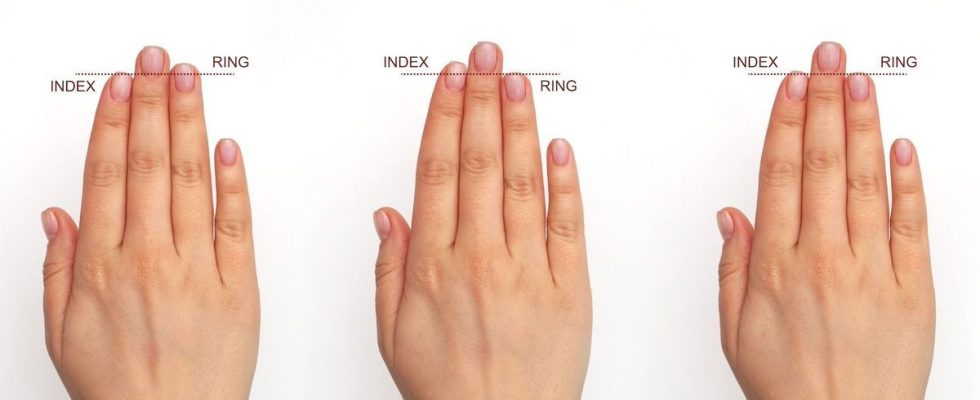Published on
Updated
Reading 4 min.
The length of your fingers (especially your index and ring fingers) could reveal certain traits of your personality or your physical abilities. Discover these studies with surprising… and controversial results.
The gap between the index and ring fingers (called the 2D:4D ratio) is believed to be linked to in utero exposure to different hormones. A phenomenon that certain studies link to sporting performance, obesity, aggressiveness or even psychopathic tendencies… Focus on these discoveries which remain the subject of debate.
The impact of fetal exposure to testosterone
Dr Ben Serpell, a sports specialist at the University of New England, said in MailOnline: “The 2D:4D ratio is associated with your mother’s hormone levels. It is believed to be established in the uterus by the end of the first trimester and is linked to prenatal exposure to testosterone”.
Indeed, during gestation, the fetus is subject to different levels of sex hormones: estrogens, the female hormones, promote the lengthening of the index finger while testosterone, the male counterpart, contributes to the formation of long ring fingers.
As a result, men and women do not have the same ratio between the length of the index finger and that of the ring finger. This number, called the Manning index or 2D/4D ratio, tends towards 1 for women and is around 0.96 for men.
A ring finger longer than your index finger means the 2D:4D ratio is low. Conversely, if the index finger is longer than the ring finger, the 2D:4D ratio is high.
Beyond gender, this ratio between your index and ring fingers would therefore reflect your exposure to these hormones during your development in utero. According to Dr. Serpell, the level of testosterone in the mother’s uterus is associated with sensitivity to testosterone while growing up.
What does a ring finger longer than the index finger reveal?
If you have an exceptionally low 2D:4D ratio, this could be a good sign for your athletic performance!
Researchers carried out a study on 24 professional footballers aged under 17. The goal was to measure their physical fitness and the length of their fingers. The results showed that the longer the ring finger is in relation to the index finger, the better the sports performance.
A little less positive: this same ratio could reveal aggressive behavior in individuals. In fact, researchers from the University of Alberta carried out a study on 298 students. They showed that men with lower ratios received more penalties during an ice hockey season.
Even more worrying, this characteristic has been associated with an increased risk of opioid use, an antisocial personality, a greater tendency to infidelity and even psychopathic tendencies.
Dr. Ben Serpell points out that although testosterone can induce certain aggressive behaviors, it is far from being the only factor: “Although certain traits associated with a lower 2D:4D ratio may be viewed negatively in some contexts, they may also be advantageous in others, such as in competitive or challenging situations.”.
And an index finger longer than the ring finger?
A high 2D:4D ratio would therefore be associated with the opposite characteristics seen above.
A study done by the Beijing International Headache Center found that women with higher 2D:4D ratios were less prone to migraines. On the other hand, an index finger longer than the ring finger could lead to a greater risk of developing obesity.
In a 2017 paper, researchers at the Medical University of Lodz found that among 100 men and women who underwent reconstructive nose surgery, a higher 2D:4D ratio was associated with greater postoperative pain in women.
A theory that remains very controversial
All of these traits associated with the 2D:4D ratio constitute only a limited sample of the numerous studies published on the subject. Indeed, the size gap between the index and ring fingers has also been associated with sexual orientation, parental poverty, menstrual pain and even the ability to jump high.
However, all of these hypotheses are based on the fact that finger length would be reliably linked to an individual’s exposure to prenatal hormones and that this exposure would be capable of inducing specific behaviors or physical abilities. But some scientists are far from convinced and even denounce a lack of convincing evidence to support this theory.
Questioned about the study linking psychopathy to this physical characteristic, Amélie Boukhbza, clinical psychologist and member of our committee of experts estimated that: “Although there are studies that explore the possibility of a relationship between the 2D:4D ratio and psychotic traits, the results cannot be interpreted as definitive evidence. Psychology and psychiatry recognize that psychotic traits, like most personality disorders, are the result of a complex interaction between genetics, environment, and life experiences. Psychotic traits are influenced by many factors, and it is unlikely that a physical measure like the 2D:4D ratio can serve as a reliable prediction on its own.”.
“We can link the 2D:4D ratio to anything and everything!”
Even more critically, Professor James Smoliga, a physiologist from Tufts University, believes that it would be possible to link the 2D:4D ratio to anything! And to prove the incongruity of these links, he carried out a “test” experiment responsible for studying the link between the 2D:4D ratio and the percentage of body fat of an individual but also his chances of success in various games totally random.
THE results published in the Bristih Medical Journal in 2021 have highlighted a link between the 2D:4D ratio and the body fat rate of individuals but an even stronger link with the probability of drawing a good hand in poker!
Suffice to say that we are on the verge of a great scientific nonsense…
